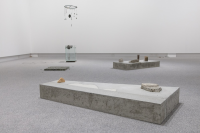
It was a surprise to visit Greenfield & Meharry’s collaborative exhibition, Alchemy at the Ashburton Art Gallery and to find myself thinking of that champion of the Arts and Crafts Movement in the mid-nineteenth century, William Morris and his legendary advice: ‘Have nothing in your house that you do not know to be useful, or believe to be beautiful.’
It must be at least forty years since it has come to mind, yet it seemed entirely appropriate to Alchemy, as well as the Ashburton Art Gallery’s other group exhibitions, its partnership with The Physics Room’s The Moon and the Pavement and the touring exhibition, Prizewinning Landscape Paintings from the Kelliher Art Trust Collection. Arguably, all three have the materials of an artist’s practice as central to their subjects and two of the three exhibitions also direct attention to reflection and contemplation on the seemingly small details of our experience of the world.
Even in just its title, Alchemy invites us to take a closer look at artist’s practice – not so much the outcome of their making but the materials and processes of creation and production. In the display of the ceramic artist’s tools and materials, it is the surprise in the quality, diversity and process of gathering artist’s clay from the earth and the crafting of vessels and containers that materialise as practical as they are objects of beauty and pleasure. Alchemy might sound like an exhibition stating the obvious but the range and diversity of the colour, tonality and hue of clays displayed in the Ashburton Gallery foyer and exhibition space upstairs were a revelation. Clays collected by Greenfield & Meharry from ‘ the lands of Kāti Huirapa ki Arowhenua situated on the Kā Pākihi-whakatekateka-a Waitaha (Canterbury Plains) between the Rivers of Rakaia and the Rangitata’ are given due attention as unique materials of central importance to the area ‘on which we stand.’ Alchemy is timely and inspirational.
The group exhibition, The Moon and the Pavement is anchored in the urban environment, its agendas and philosophies closely aligned to its participating artists: Teresa Collins, Yukari Kaihori, Susu, and Sam Towse. In a series of new works, the immediate and intimate experiences and connections to our daily lives are equally central to the agenda of The Moon and the Pavement, yet, in its attention to the materiality of its subjects, also serving as a counterpoint and complementary exhibition to Alchemy.
Fundamental to The Moon and the Pavement is the paradox of life in the 21st century, encompassed in The Physics Room introduction to the exhibition as it being about ‘feet on the ground, head in the internet, couched in the reality of the constant and persistent call on the cellphone.’ And without reading further, it is our encounter with materials and surfaces throughout the exhibition that is critical to its success, the transformation of discarded objects by, for example; Teresa Collins into ‘fishing-wire-suspended mobiles,’ or Yukari Kaihori’s use of found materials, ‘transformed into new versions of themselves.’
As a survey exhibition that has its origins in the 1950s, the current touring exhibition, Prizewinning Landscape Paintings from the Kelliher Art Trust Collection may seem like a curiously estranged companion. Certainly, where the tangible materiality of the land may seem all too well-dressed to be credible in its smartly-framed paintings, it must be noted that the connection to place and belonging in the period represented by the exhibition was central to the success of the Kelliher Award. Certainly, The Kelliher could equally have once claimed William Morris’ recommendation to ‘have nothing in your house that you do not know to be useful, or believe to be beautiful.’
IMAGES
- Greenfield & Meharry, Alchemy, installation, photograph: Shirin Kosraviani
- The Moon and the Pavement, installation photograph, work in the immediate foreground is by Sam Towse, photograph: Shirin Kosraviani
